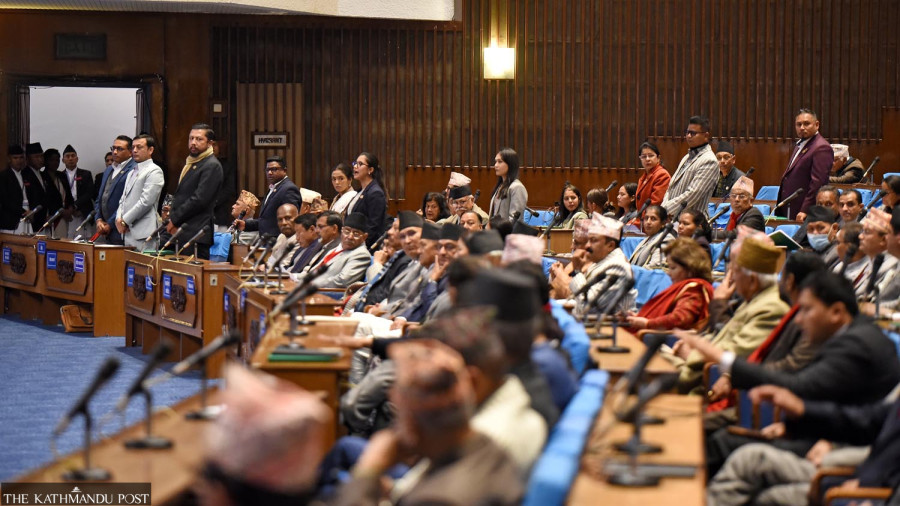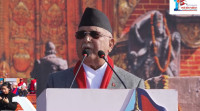Politics
Ordinances are hailed or slammed depending on parties’ positions
Many do not care about their contents but oppose the process of legislation.
Purushottam Poudel
The government presented six ordinances, which it enforced earlier, at Friday’s Parliament meeting amid criticism from the opposition parties.
Lawmakers from various opposition parties registered 50 notices of rejection of the ordinances at the parliament secretariat on Sunday.
Secretariat spokesperson Ekram Giri confirmed the registration of 50 notices of rejection of the ordinances.
As the House of Representatives is scheduled to meet next on Thursday, it is likely to see a heated debate over the rationale behind amending laws through an ordinance and their contents.
Ever since the government introduced six ordinances, the opposition parties have accused the government of making changes in the laws bypassing the legislature. However, the ruling parties have claimed that it was not a crime to make changes in the laws for a cause when Parliament is not in session. It’s a constitutional measure and successive governments have done so, they argue.
Prime Minister KP Sharma Oli, ministers in his Cabinet and leaders from the ruling parties have argued that the ordinances were aimed at, among other things, creating a business environment and attracting investment in the country.
Leaders from the business community have supported the government move. They publicly appreciated it saying that the government, through the ordinances, removed some legal hurdles in doing business.
There was a similar scenario last year.
The Pushpa Kamal Dahal-led government introduced a couple of ordinances just hours before the inauguration of the Nepal Investment Summit in April 2024. Government officials gave the same reasons behind introducing the ordinances and those from the business community and some development experts lauded the government for it. They said the move would help attract foreign investors as it removed various legal hurdles.
Then, what changes did that bring about? Did the ordinances really work as per the objectives given at the time of their enforcement?
Rameshore Khanal, chair of the government-formed High-Level Economic Sector Reform Recommendation Commission, claims that ordinances make some quick fixes that would otherwise be tangled without the law.
“Foreign enterprises that invested in the alternative financial sector of Nepal earlier were not able to repatriate their earnings after selling their shares in a company should they leave Nepal. The ordinances brought just before the investment summit facilitated them to take back their share money,” said Khanal, also a former finance secretary. “Investors were earlier reluctant to invest in Nepal just citing financial insecurity but that is not the case after the law amendment.”
Khanal added that passing bills into law and then implementing them is time-consuming, which delays outcomes.
The ordinance itself is a law; it is better to have a law than keep the country in a void, says Debendra Paudel, a leader of the main opposition CPN (Maoist Centre).
“Though there are two ways of making and changing laws, the spirit of the constitution is definitely not to make more laws from ordinances than bills,” Paudel said. “Most of the ordinances get their objective fulfilled.”
Usually, the government introduces ordinances when Parliament is not in session to address a problem when the absence of law could hinder the work that must be done urgently. However, an ordinance must be replaced by a regular bill. The replacement bill must be presented in the first meeting of the House that sits after the issuance of the ordinance and the bill must be endorsed by Parliament within 60 days of the first meeting.
“An ordinance can also be amended or failed after tabling it in Parliament, but the practice in Nepal is to bring an ordinance just to bypass the House rather than to achieve results,” Prakash Chandra Lohani, a former finance and foreign minister, said.
In five years, the governments formed after the 2017 general election issued 36 ordinances, some repeatedly. While some of them passed both houses, some were later withdrawn by the government. At the same time, some became void as they were not presented for necessary parliamentary process.
The government introduced 36 ordinances while the House passed 101 bills during its five-year tenure. Thus, the total ordinances introduced by the government accounted for 35.64 percent of the bills passed by the House.
After more than two years since the November 2022 election, the current Parliament has passed only 11 bills. In this period, the government introduced more ordinances than the bills passed.
The Pushpa Kamal Dahal-led government introduced nine ordinances just hours before the inauguration of the Third Investment Summit last year, to improve the investment climate in the country. The incumbent government, led by KP Sharma Oli, recently introduced six ordinances.
An ordinance may be necessary when Parliament is not in session or when it cannot be convened immediately. But Taranath Ranabhat, a former Speaker, says it is unusual when the number of ordinances the government introduces outnumber the bills passed by Parliament.
“We hold the periodic election of Parliament at a financial cost so that parliamentarians formulate bills to govern the country,” said Ranabhat. “But, when Parliament cannot produce bills and the government issues ordinances, that undermines the essence of Parliament.”
Lohani echoes Ranabhat. But, he argues that issuing an ordinance in the absence of the House might fast-track the legislation but there is no fundamental gain since the ordinance also goes through the same process of a bill later.
After the coalition of the Nepali Congress and the CPN-UML, led by KP Sharma Oli, introduced five different ordinances on January 1, which President Ramchandra Paudel approved on January 13, opposition parties including the CPN (Maoist Centre) slammed the decision.
On December 25 last year, the government also introduced the ordinance amending the law governing cooperatives, which the President duly approved.
On April 23 last year, the government forwarded an ordinance amending nine Acts to remove legal complexities and attract investors. The ordinance was later presented in Parliament and endorsed by both chambers.
Various provisions of the Land Act, the National Parks and Wildlife Conservation Act, the Land Acquisition Act, the Electronic Transactions Act, the Special Financial Act, the Public Private Partnership and Investment Act, the Foreign Investment and Technology Transfer Act, the Forest Act, and the Industrial Enterprises Act have been amended through the ordinance.
Then the main opposition, Nepali Congress had expressed serious reservations about the government’s decision to introduce the ordinance, claiming it to be a move against the spirit of parliamentary democracy.
“Such work undermines the dignity and importance of institutions representing the people and the federal democratic republican system,” the chief whip of the party, Ramesh Lekhak, had stated.
Ghanashyam Ojha, director general of the Confederation of Nepali Industries, appreciates the ordinances brought by both governments claiming that they have helped improve the business environment.
“One of the ordinances brought by the current government has tweaked legal provisions to allow Nepali IT companies to invest abroad, repatriate their incomes and to allow them to open branches in a foreign country. This is a good initiative,” Ojha said.
When the political parties question the government's motive for introducing the ordinances, accusing it of hijacking parliamentary democracy, while they are in the opposition, they defend similarly introduced ordinances when they are in power. But, whether the ordinances achieve their goal is seldom discussed.
Ranabhat, the former Speaker, says that not every ordinance meets its objective. Ordinances are a form of law, and the effectiveness of any law depends on how it is implemented, he adds.




 9.12°C Kathmandu
9.12°C Kathmandu















